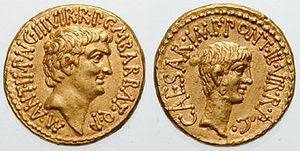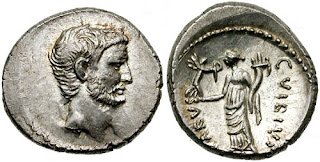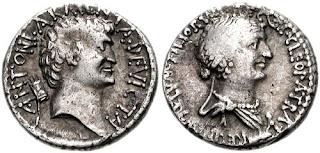 | Following the assassination of Caesar in 44 BCE, Rome was plunged into chaos. Many of Caesar’s conspirators, including M. Junius Brutus and C. Cassius Longinus, (Brutus and Cassius) fled Rome in fear of reprisal. Caesar’s ally, M. Antonius (Marc Antony) seized control during the power vacuum, with the conspirators on the run and Caesar’s designated heir, G. Octavius Thurinus, (Octavian) still with an army in Macedonia. He returned to Rome with a new name, G. Julius Caesar Octavianus. |
 This left Octavian in command of all of their eight legions. Octavian began negotiations with Antony. | In the spring of 43 BCE, Octavian, along with the consuls Aulus Hirtius and G. Vibius Pansa Caetronianus, conquered Antony and his five legions at the Battle of Mutina in Cisalpine Gaul. Though victorious, Hirtius was killed and Pansa died of possible poisoning. |  Octavian, Antony, and Lepidus established a three-man dictatorship. Octavian, Antony, and Lepidus established a three-man dictatorship. |
 | Antony, desperate to retain troops, began to strike one of the more iconic series of coinage in Rome’s history, the legionary denarius. These coins allude directly to the events of the day, as they feature a praetorian galley. On September 2, 31 BCE, the forces of Octavian and M. Vipsanius Agrippa defeated Mark Antony and Cleopatra at Actium, a promontory between the Ambracian Gulf and the Ionian Sea. Antony and Cleopatra were forced to retreat for Egypt. The final defeat was the Battle of Alexandria on August 1, 30 BCE. It was the official end of the Roman Republic and the start of the Roman Empire. |





No comments:
Post a Comment